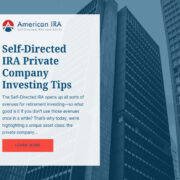Estate Planning with Self-Directed Solo 401Ks and Self-Directed IRAs
If you are like most retirement investors, your accounts— Self-Directed IRAs and Self-Directed Solo 401Ks—make up a large part of your overall savings. Statistically, they make up over a third of all investments in the U.S. After your death, distributions from those accounts will be required, and transferring the assets to your heirs could be a thorny issue if you have not designated your beneficiaries properly.
Those designations are an important part of your estate plan, so you want to make sure you get them right, or your heirs could end up paying more income and estate taxes than necessary. You can adapt your designations to match your wishes. The most frequent beneficiaries are:
- Spouse
- Children
- Grandchildren
- Other loved ones
- Trust
- Charity
- Almost any combination of these
With all these choices, it is not surprising that Self-Directed IRA and Self-Directed Solo 401K owners often make mistakes–some of them are errors of omission–when designating their beneficiaries. These mistakes can be costly to your heirs since they could receive less (possibly nothing), and much of the money you worked a lifetime to save might not end up with the people you love.
Here are some of the most frequent mistakes and tips for avoiding a future nightmare for your heirs:
Not naming a beneficiary
This mistake is first on the list because it is probably the biggest blunder you can make on your retirement accounts. When you die without designating beneficiaries, those accounts will go through probate, an expensive and time-consuming process. The person who becomes beneficiary might not be someone you would have chosen, and even if they are, they will not be able to stretch the benefits over their lifetime because the account would need to be liquidated within five years.
Not having contingent beneficiaries
It is not unusual for Self-Directed IRA and Self-Directed Solo 401K owners to designate their spouse as a beneficiary and leave it at that. But what if something happens to both of you. Once again, your accounts would end up in court. It is much better to have designated contingent beneficiaries. If something like that happens, your accounts will avoid probate.
Not using a trust to protect assets
Designating a beneficiary will ensure that your assets are transferred properly, but some financial planners advise that you place those assets in trusts to protect them from an ex-spouse or creditors. You can even protect the beneficiary from his or her careless spending habits by using a “spendthrift” restriction on the assets.
Trusts are complex. Make sure you have experienced, professional help in setting them up.
Naming the wrong contingent beneficiaries
You can run into potential problems by naming a contingent beneficiary with a short life expectancy. For example, you name your children as beneficiaries. If they die before you, your grandchildren are next in line, and if they should all die, your brother is next.
Even though your brother will probably never inherit your assets, he has the shortest life expectancy, and his age will determine how quickly the assets must be withdrawn. It is critical to have an estate attorney look at your designations to avoid potential problems like this.
Not checking and updating the beneficiaries regularly
If you have an ex-spouse, here is an unsettling thought: If you neglected to update your beneficiaries after the break-up, guess who’s in line to receive your retirement assets when you die? Do you really want your current spouse to have the hassle of going to court to try to get your assets?
You need to check and update your beneficiaries regularly. Some of them might not be alive any longer, and some might not have been born when you last updated them. Make sure your retirement assets are going where you want them to by confirming that your designated beneficiaries are current.
Missing out on the “stretch”
Younger beneficiaries can “stretch” mandatory withdrawals over many decades, keeping their assets’ tax-deferred status in place and allowing the account to grow. As mentioned previously, choosing an older beneficiary could reduce the stretch considerably and increases taxes for your heirs as funds are withdrawn sooner and in larger chunks.
Not coordinating estate and retirement planning
When estate planners and investment advisors do not work together, the chances that your assets will end up where you hoped they would are reduced quite a bit. It is crucial that you set up your Self-Directed IRA and Self-Directed Solo 401K beneficiaries and work closely with estate planning professionals, so problems can be spotted early enough to take care of them.
Interested in learning more about Self-Directed IRAs? Contact American IRA, LLC at 866-7500-IRA (472) for a free consultation. Download our free guides or visit us online at www.AmericanIRA.com.






